Summary This report describes the activities of the Mobile Veterinary Unit in Meru for the month of June 2013
Summary
This report describes the activities of the Mobile Veterinary Unit in Meru for the month of June 2013. Key among these activities was capture and translocation of 14 elephant bulls from Lewa wildlife conservancy (LWC) and Ol Pejeta conservancy (OPC) to Meru national park (MNP). The activity, which was carried out from 2nd to 24th June 2013 in collaboration with the Veterinary and capture team from KWS headquarters, aimed to move habitual fence breaking elephants to the larger Meru conservation area to reduce human wildlife conflict by crop raiding elephants in agricultural areas in Laikipia.
The unit also relocated into Meru park a female zebra that had strayed out of the park into community land. In addition an injured elephant was reported in Namunyak community conservancy but an attempt to dart for treatment was not successful.
Translocation of elephants from Lewa and Ol pejeta conservancy to Meru national park
Prior to the actual translocation elephant herds were monitored for several weeks by experienced scouts from the conservancies to identify candidates for translocation. Aerial recce and GSM collars were deployed to monitor movements of elephant herds.
Darting was conducted from a helicopter using the Dan-Inject® darting system. The immobilization drug used was etorphine hydrochloride (M99®) 18mg into which hyaluronidase 3500 i.u was added to enhance the absorption of the drug from the darting site. The preferred darting sites were the hindquarters on the rump or thigh muscle.
Candidates for darting were identified by an experienced spotter in the helicopter, after which the individual was driven to an open field for darting.
Immobilized elephants were loaded into recovery trucks using cranes and transported to the loading site in a narcotized state. At the loading site, immobilised elephants were transferred into a recovery crate. Here the elephants were revived from anesthesia by intravenous administration of diprenophine Hcl (M5050®) 54 mg intravenously.
Animals were then prodded into an appropriate transportation crate. Animals were transported singly in each of the two chambers of the container to prevent fighting and resulting injuries among the dominant bulls.
At the release site in MNP, the transportation truck was reversed into an offloading ramp and the elephants allowed to walk out voluntarily from the crate.
Results and discussion
Fourteen male elephants were translocated on various dates between 2nd June and 14th June 2013, four from LWC and 10 from OPC (Table 1). The target was 16 elephants; however two candidates for translocation in LWC could not be traced in time.
This represented a trial phase to monitor how the elephants will settle down in Meru conservation area. Elephants traverse a wide range and some translocated individuals have been shown to return to their previous home range after translocation. In this case GSM collars were deployed for post translocation monitoring of individuals.
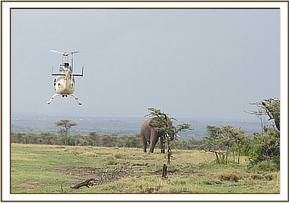
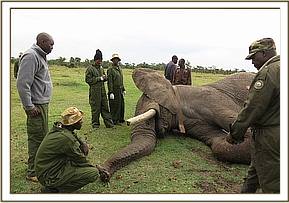
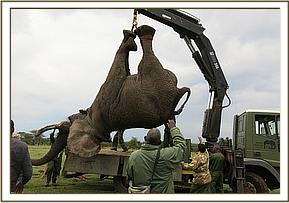
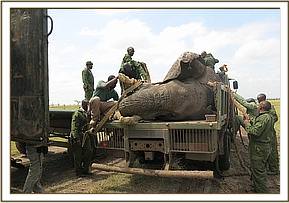
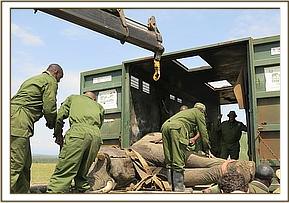
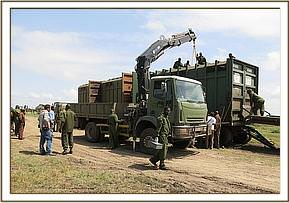

Relocation of a male zebra
The community warden at MNP reported that a female adult zebra had strayed out of the park to community area known as nkurunga, approximately 40 kilometers south east of the park. The zebra which was seen among a herd of cattle was habituated but there were fears that it might become wild and dangerous to livestock and people.
Standard immobilization procedure was followed. Darting was conducted on foot using Dan-Inject® darting system. The dart syringe contained Etorphine Hcl 7 mg and Azaperone Hcl 50mg in a single 3 milliliter dart. Induction time was three minutes.
A blindfold was used to prevent visual stimulation. The zebra was loaded into a truck and anesthesia reversed using Diprenophine Hcl 18mg injected intravenously into the jugular vein.
The journey to the park lasted one hour.


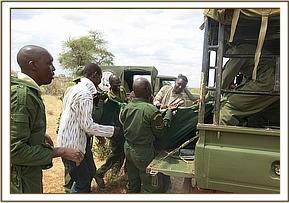
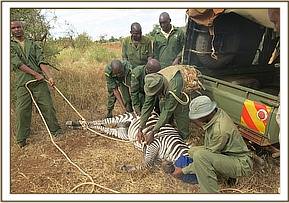

Other cases
Namunyak conservancy reported an injured male adult elephant. Attempts to dart were unsuccessful due to the thick bush and rough terrain. The animal is being monitored.
Acknowledgements
The Meru MVU is grateful for logistical and financial support offered by the David Sheldrick Wildlife Trust.